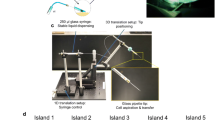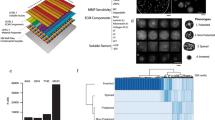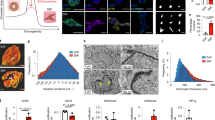Abstract
Extracellular matrix is a key regulator of normal homeostasis and tissue phenotype1. Important signals are lost when cells are cultured ex vivo on two-dimensional plastic substrata. Many of these crucial microenvironmental cues may be restored using three-dimensional (3D) cultures of laminin-rich extracellular matrix (lrECM)2. These 3D culture assays allow phenotypic discrimination between nonmalignant and malignant mammary cells, as the former grown in a 3D context form polarized, growth-arrested acinus-like colonies whereas the latter form disorganized, proliferative and nonpolar colonies3. Signaling pathways that function in parallel in cells cultured on plastic become reciprocally integrated when the cells are exposed to basement membrane–like gels4,5,6,7. Appropriate 3D culture thus provides a more physiologically relevant approach to the analysis of gene function and cell phenotype ex vivo. We describe here a robust and generalized method for the culturing of various human breast cell lines in three dimensions and describe the preparation of cellular extracts from these cultures for molecular analyses. The procedure below describes the 3D 'embedded' assay, in which cells are cultured embedded in an lrECM gel8 (Fig. 1). By lrECM, we refer to the solubilized extract derived from the Engelbreth-Holm-Swarm mouse sarcoma cells9. For a discussion of user options regarding 3D matrices, see Box 1. Alternatively, the 3D 'on-top' assay, in which cells are cultured on top of a thin lrECM gel overlaid with a dilute solution of lrECM, may be used as described in Box 2 (Fig. 1 and Fig. 2).
This is a preview of subscription content, access via your institution
Access options
Subscribe to this journal
Receive 12 print issues and online access
$259.00 per year
only $21.58 per issue
Buy this article
- Purchase on Springer Link
- Instant access to full article PDF
Prices may be subject to local taxes which are calculated during checkout



Similar content being viewed by others
References
Bissell, M.J., Radisky, D.C., Rizki, A., Weaver, V.M. & Petersen, O.W. The organizing principle: microenvironmental influences in the normal and malignant breast. Differentiation 70, 537–546 (2002).
Bissell, M.J., Kenny, P.A. & Radisky, D.C. Microenvironmental regulators of tissue structure and function also regulate tumor induction and progression: the role of extracellular matrix and its degrading enzymes. Cold Spring Harb. Symp. Quant. Biol. 70, 343–356 (2005).
Petersen, O.W., Ronnov-Jessen, L., Howlett, A.R. & Bissell, M.J. Interaction with basement membrane serves to rapidly distinguish growth and differentiation pattern of normal and malignant human breast epithelial cells. Proc. Natl. Acad. Sci. USA 89, 9064–9068 (1992).
Anders, M. et al. Disruption of 3D tissue integrity facilitates adenovirus infection by deregulating the coxsackievirus and adenovirus receptor. Proc. Natl. Acad. Sci. USA 100, 1943–1948 (2003).
Bissell, M.J., Rizki, A. & Mian, I.S. Tissue architecture: the ultimate regulator of breast epithelial function. Curr. Opin. Cell Biol. 15, 753–762 (2003).
Wang, F. et al. Phenotypic reversion or death of cancer cells by altering signaling pathways in three-dimensional contexts. J. Natl. Cancer Inst. 94, 1494–1503 (2002).
Wang, F. et al. Reciprocal interactions between beta1-integrin and epidermal growth factor receptor in three-dimensional basement membrane breast cultures: a different perspective in epithelial biology. Proc. Natl. Acad. Sci. USA 95, 14821–14826 (1998).
Liu, H., Radisky, D.C., Wang, F. & Bissell, M.J. Polarity and proliferation are controlled by distinct signaling pathways downstream of PI3-kinase in breast epithelial tumor cells. J. Cell Biol. 164, 603–612 (2004).
Kleinman, H.K. et al. Isolation and characterization of type IV procollagen, laminin, and heparan sulfate proteoglycan from the EHS sarcoma. Biochemistry 21, 6188–6193 (1982).
Weaver, V.M. et al. Reversion of the malignant phenotype of human breast cells in three-dimensional culture and in vivo by integrin blocking antibodies. J. Cell Biol. 137, 231–245 (1997).
Weaver, V.M. et al. beta4 integrin-dependent formation of polarized three-dimensional architecture confers resistance to apoptosis in normal and malignant mammary epithelium. Cancer Cell 2, 205–216 (2002).
Sambrook, J., Fritsch, E.F. & Maniatis, T. Molecular Cloning: A Laboratory Manual (Cold Spring Harbor Laboratory Press, Cold Spring Harbor, New York, 1989).
Kenny, P.A. et al. The morphologies of breast cancer cell lines in three-dimensional assays correlate with their profiles of gene expression. Mol. Oncol. (in the press).
Kleinman, H.K. & Martin, G.R. Matrigel: basement membrane matrix with biological activity. Semin. Cancer Biol. 15, 378–386 (2005).
Auerbach, R., Lewis, R., Shinners, B., Kubai, L. & Akhtar, N. Angiogenesis assays: a critical overview. Clin. Chem. 49, 32–40 (2003).
Debnath, J., Muthuswamy, S.K. & Brugge, J.S. Morphogenesis and oncogenesis of MCF-10A mammary epithelial acini grown in three-dimensional basement membrane cultures. Methods 30, 256–268 (2003).
Toda, S. et al. A new organotypic culture of thyroid tissue maintains three-dimensional follicles with C cells for a long term. Biochem. Biophys. Res. Commun. 294, 906–911 (2002).
Tonge, D., Edstrom, A. & Ekstrom, P. Use of explant cultures of peripheral nerves of adult vertebrates to study axonal regeneration in vitro. Prog. Neurobiol. 54, 459–480 (1998).
Vaughan, M.B., Ramirez, R.D., Wright, W.E., Minna, J.D. & Shay, J.W. A three-dimensional model of differentiation of immortalized human bronchial epithelial cells. Differentiation 74, 141–148 (2006).
Wang, R. et al. Three-dimensional co-culture models to study prostate cancer growth, progression, and metastasis to bone. Semin. Cancer Biol. 15, 353–364 (2005).
Fata, J.E., Werb, Z. & Bissell, M.J. Regulation of mammary gland branching morphogenesis by the extracellular matrix and its remodeling enzymes. Breast Cancer Res. 6, 1–11 (2004).
Kibbey, M.C. Maintenance of the EHS sarcoma and matrigel preparation. Methods Cell Sci. 16, 227–230 (1994).
Acknowledgements
The protocol described here has been the work of many members of the Bissell laboratory over many years. We apologize to those whose work could not be cited owing to space limitations and have cited reviews where possible. This work was supported by grants from the Office of Biological and Environmental Research of the US Department of Energy (DE-AC03-76SF00098 and a Distinguished Fellow Award to M.J.B.), the US National Cancer Institute (CA64786 to M.J.B.; CA57621 to Zena Werb and M.J.B.) and the Breast Cancer Research Program of the US Department of Defense (Innovator Award DAMD17-02-1-438 to M.J.B).
Author information
Authors and Affiliations
Corresponding author
Ethics declarations
Competing interests
The authors declare no competing financial interests.
Supplementary information
Supplementary Video 1
Time-lapse movies of HMT-3522 T4-2 cells treated with vehicle and cultured in the 3D on-top assay for 5 d. Phase contrast images were taken at 1-h intervals. (MOV 1420 kb)
Supplementary Video 2
Time-lapse movies of HMT-3522 T4-2 cells treated with an EGFR inhibitor, AG1478, and cultured in the 3D on-top assay for 5 d. Phase contrast images were taken at 1-h intervals. (MOV 1193 kb)
Rights and permissions
About this article
Cite this article
Lee, G., Kenny, P., Lee, E. et al. Three-dimensional culture models of normal and malignant breast epithelial cells. Nat Methods 4, 359–365 (2007). https://doi.org/10.1038/nmeth1015
Published:
Issue Date:
DOI: https://doi.org/10.1038/nmeth1015
This article is cited by
-
A 3D “sandwich” co-culture system with vascular niche supports mouse embryo development from E3.5 to E7.5 in vitro
Stem Cell Research & Therapy (2023)
-
Rapid biomechanical imaging at low irradiation level via dual line-scanning Brillouin microscopy
Nature Methods (2023)
-
VE-Cadherin modulates β-catenin/TCF-4 to enhance Vasculogenic Mimicry
Cell Death & Disease (2023)
-
p53 isoform expression promotes a stemness phenotype and inhibits doxorubicin sensitivity in breast cancer
Cell Death & Disease (2023)
-
Application of organoids in otolaryngology: head and neck surgery
European Archives of Oto-Rhino-Laryngology (2023)



